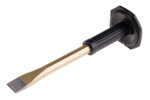When I think back to 40 odd years ago and working on live circuits with a screwdriver with TV coax sheath on the metal shaft.
I was thinking about when I would put heat shrink around the shaft, it was great when applied, but unless epoxy lined stuff used, it could slide down the shaft.
The other worry was dirt, with conducting material in it, from old engine oil for example.
When I started my dad took me to a war department surplus store and got me a start up kit, that back then was the norm, but today as volunteers on a heritage railway we are told we must not bring in our own tools, odd we can donate tools to the railway then use the tools, but to use them they need to belong to the railway.
I think this is down to being able to control safety aspects of the tools, cold chisels are a good example, the rubber type cover can be moved chisel to chisel

and also the end if not ground down can mushroom out and have bits fly off it, so the safety department needs to inspect them from time to time, same with hammers, angle grinders need the correct guards, and the wheels checking, and today we are using so many more power tools, even screwdrivers.
To make a list of which tools you can and can't bring into work would be hard, as always some new thing which has not been thought about, and insurance often means the firm has no option but provide all tools.
As to a training establishment, not sure how their insurance works, the lecturers are covered by HSE rules, they are at work, but the students are only at work if sent there by their employer, their employer in theroy should send some one to inspect the collage to see if it is safe, I saw this problem with employment agencies who are responsible for their workers, even when they have no or little control over the work environment.
I found lack of collage tools was a problem, I went to sample a NVQ course to decide if it was what I needed, and they were fitting tray, now where I worked we would in the main use pre-formed tray, but also had the rollers to form the tray where required, and using the equipment needs some skill, in the main we would cut tray with an angle grinder, and would wear the face masks and use fans etc to avoid glav flue. I was therefore dismayed to find only hack saws used in the collage so students not trained in the precautions needed when using an angle grinder, and had no rollers, so what was the point in instruction students how to install tray? Most of what they were learning was never going to be used.
We often rely on the collage to instruct the student as to the correct way to do things, even to the type of spanner, where it is all too easy to damage ones hand by using spanners which are too thin. Or the danger of a jaw opening as we exert pressure to the spanner. So a wall of shame is common, showing poor quality tools, which are often the more expensive ones, snap-on spanners were often far to thin.
So there should never really be a question of tools for collage, any good collage should be banning students from bringing in their own tools.


